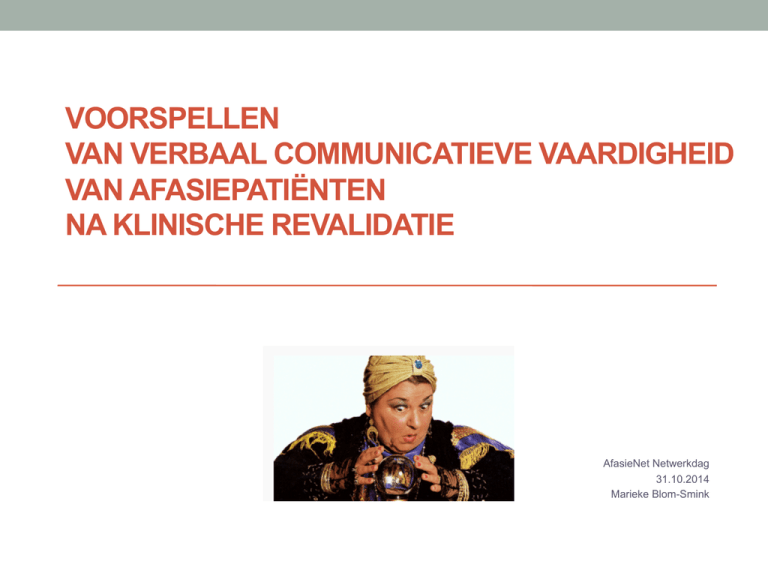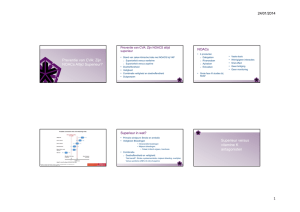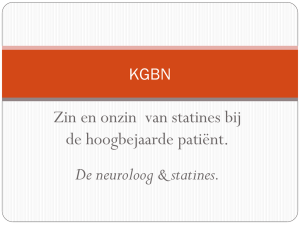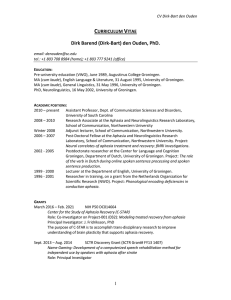voorspellen van verbaal communicatieve vaardigheid
advertisement

VOORSPELLEN VAN VERBAAL COMMUNICATIEVE VAARDIGHEID VAN AFASIEPATIËNTEN NA KLINISCHE REVALIDATIE AfasieNet Netwerkdag 31.10.2014 Marieke Blom-Smink Inhoud • predictie • predictie afasie • predictiemodel • ontwikkeling predictiemodel afasie • predictiemodel afasie • conclusies • aanbeveling Predictie • op basis van dingen die je weet → uitspraak doen over dingen die je nog niet weet • op basis van patiëntkenmerken → voorspellen van bepaalde uitkomst van aandoening over bepaalde tijdshorizon = prognose Predictie afasie patiëntkenmerken: • ernst van CVA (Mazaux et al., 2013; Pedersen et al., 2004) • type CVA (El Hachioui et al., 2013; Holland et al., 1989) • type afasie (Bakheit et al., 2007; Lendrem & Lincoln, 1985) • initiële score(s) op afasietest(s) (De Riesthal & Wertz, 2004; Lazar et al., 2008) • neuropsychologisch functioneren (Van de Sandt-Koenderman et al., 2008) • tijdsinterval CVA - start afasietherapie (Robey, 1998; Van der Meulen et al., 2014) • leeftijd (El Hachioui et al., 2013; Holland et al., 1989) • geslacht (Holland et al., 1989) • opleidingsniveau (El Hachioui et al., 2013) Predictiemodel • predictiemodel = evidence-based model voor prognose • predictiemodel = rekenkundig model • klinisch predictiemodel → accurate prognose • betrouwbare informatie over beloop aandoening • keuze van behandeling Ontwikkeling predictiemodel afasie • doel: • model om verbaal communicatieve vaardigheid bij ontslag uit klinische revalidatie (ANTAT-A) te voorspellen voor patiënten met matige / ernstige afasie a.g.v. beroerte (AAT-CG score 3 of lager) • eenvoudig te gebruiken in klinische praktijk Ontwikkeling predictiemodel afasie • potentiële predictoren: • leeftijd • geslacht • type CVA • tijdsinterval CVA -­‐ opname klinische revalidatie • testscores bij opname klinische revalidatie: • ANTAT-A • ScreeLing semantiek • ScreeLing fonologie • Barthel Index Predictiemodel afasie • ANTAT-A score bij ontslag = ? + ? • leeftijd ? • geslacht ? • type CVA ? • tijdsinterval CVA - opname klinische revalidatie ? • ANTAT-A score bij opname ? • ScreeLing semantiek ? • ScreeLing fonologie ? • Barthel Index ? Predictiemodel afasie • ANTAT-A score bij ontslag = 7,55 + 0,85 * (score ScreeLing fonologie) + 0,56 * (score ANTAT-A bij opname) • ANTAT-A score bij ontslag = 7,55 + (0,85 * 19,5) + (0,56 * 26) = 39 Conclusies • proefmodel om verbaal communicatieve vaardigheid van afasiepatiënten bij ontslag uit klinische revalidatie te voorspellen • eenvoudig te gebruiken in klinische praktijk • gebaseerd op routinematig verkregen testscores • fonologie lijkt belangrijke voorspeller te zijn van verbaal communicatieve vaardigheid van patiënten met afasie a.g.v. CVA Aanbeveling • afasiediagnostiek > fonologie in kaart brengen bij patiënten met afasie a.g.v. beroerte t.b.v. prognosestelling Literatuur • Bakheit, A.M.O. et al. (2007). The rate and extent of improvement with therapy from the different • • • • • • • • • • • • types of aphasia in the first year after stroke. Clinical Rehabilitation, 21(10), 941-949. De Riesthal, M., & Wertz, R.T. (2004). Prognosis for aphasia: Relationship between selected biographical and behavioural variables and outcome and improvement. Aphasiology,18(10), 899-915. El Hachioui, H. et al. (2013). Long-term prognosis of aphasia after stroke. Journal of Neurology, Neurosurgery and Psychiatry, 84(3), 310-315. Holland, A.L. et al. (1989). Predictors of language restitution following stroke: A multivariate analysis. Journal of Speech and Hearing Research, 32(2), 232-238. Lazar, R.M. et al. (2008). Variability in language recovery after first-time stroke. Journal of Neurology, Neurosurgery and Psychiatry, 79(5), 530-534. Lendrem, W., & Lincoln, N.B. (1985). Spontaneous recovery of language in patients with aphasia between 4 and 34 weeks after stroke. Journal of Neurology, Neurosurgery, and Psychiatry, 48(8), 743-748. Mazaux, J.-M. et al. (2013). Communication activity in stroke patients with aphasia. Journal of Rehabilitation Medicine, 45(4), 341-346. Moons, K.G.M. et al. (2009). Prognosis and prognostic research: What, why and how? British Medical Journal, 338, b375. Pedersen, P.M. et al. (2004). Aphasia after stroke: Type, severity and prognosis. The Copenhagen Aphasia Study. Cerebrovascular Diseases, 17(1), 35-43. Revalidatie Nederland (2012). Factsheet Revalidatie na een beroerte. Robey, R.R. (1998). A meta-analysis of clinical outcomes in the treatment of aphasia. Journal of Speech, Language, and Hearing Research, 41(1), 172-187. Van de Sandt-Koenderman, W.M.E. et al. (2008). MAAS (Multi-Axial Aphasia System): Realistic goal setting in aphasia rehabilitation. International Journal of Rehabilitation Research, 31(4), 413-320. Van der Meulen, I. et al. (2014). The efficacy and timing of melodic intonation therapy in subacute aphasia. Neurorehabilitation and Neural Repair, 28(6), 536-544.


